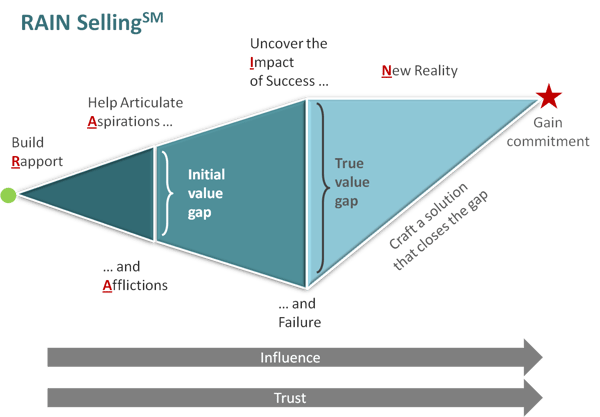It’s 4 PM on a Thursday. You’re about to meet the CEO of a large company you’d like to win as a client. The conversation starts as you walk into the office, approach the CEO, stretch out your hand, and say, “Nice to meet you, Jill. I’m Steve Webb.”
Fast forward 7 months later. It’s 3 PM on a Wednesday. You head into the office. Jill gets out from behind her desk and says, “Good to see you again, Steve. Here’s the signed contract for the initial $1.2 million. Let’s get started.”
Suffice it to say, a lot has to happen between “hello” and “let’s go.”
Yet two things are true. 1) This is how it happens. And, 2) how to lead sales conversations, influence your prospects to want to buy, buy from you, buy a robust solution, and pay full price for it confounds many people.
But it doesn’t have to.
At RAIN Group, our RAIN SellingSM methodology is the blueprint that helps sellers, entrepreneurs, and professionals around the globe lead masterful sales conversations, run effective sales processes, create and win sales opportunities, and overall unleash their sales potential and results. Download our ebook, RAIN Selling: Keys to Leading Masterful Sales Conversations, to learn more.
At the heart of the RAIN SellingSM methodology is the acronym RAIN. Along with lending itself as the name of the overall method, the word RAIN is your guide to leading masterful sales conversations.
RAIN stands for:
- Rapport
- Aspirations and Afflictions
- Impact
- New Reality
And the “A” and the “I” perform double duty as reminder to balance Advocacy and Inquiry, and the “IN” will help you to remember to maximize your Influence.

The RAIN Sales Conversation Framework
1. Rapport
Despite recent claims in the Harvard Business Review that “Selling Is Not About Relationships,” our What Sales Winners Do Differently research found results to the contrary. The ability to connect with buyers and build strong relationships with them is not only still relevant, it’s more important than ever. And while rapport and personal connections don't represent the totality of strong business relationships, they're still very important.
Building rapport is sometimes dismissed as a ploy to make a superficial connection with a potential buyer. We agree—you shouldn’t make superficial connections, you should make genuine connections. Genuine rapport sets the table for the rest of the conversation and creates the foundation for trust. A genuine connection with a prospect is so important in selling because, all things being equal, buyers buy from people they like. Rapport is not enough to win, but without it, you don’t get very far.
2. Aspirations and Afflictions
Many sales methodologies suggest that to sell products and services as solutions to needs, you must first uncover the “problem” or “pain.” However, these words all too often drive sellers to employ find-out-what’s-wrong-and-fix-it thinking. Let’s say the buyer doesn’t perceive anything to be wrong. Soothe-the-pain sellers find themselves at a dead end. No problems to fix means nothing to sell.
The sellers most successful at creating opportunities focus much more on the positives—goals, aspirations, and possibilities achievable by the buyer, even if the buyer doesn’t know it yet. Sellers who focus on aspirations as well as afflictions are able to directly influence the buyer’s agenda—and drive their own demand—by inspiring buyers with possibilities they hadn’t been considering, but should be.
Think of Aspirations as much as Afflictions, and you will remember to ask “future-seeking” as well as problem-solving questions—questions with themes like “Where do you want to go?” and “What are the possibilities?”
3. Impact
After you uncover a prospect’s aspirations and afflictions, the question becomes, “So what?” If your afflictions don’t get solved, so what? What won’t happen? Will they get worse? How will they affect the bottom line of your company, division, or department? How will they affect your life?
If your aspirations don’t become reality, so what? Will your competition get ahead of you if you don’t innovate? Will you lose market share if you aren’t aggressive in your strategy? Will you never be able to grow your business to a point where you can sell it and reach your personal financial goals? Will the promotion you desire continue to elude you?
The exact ‘‘so what’’ questions will vary depending on the situation, but your ability to quantify and paint the ‘‘so what’’ picture is the foundation for how important it is for the decision maker to buy from you. The more impact, the more urgency to buy.
4. New Reality
One of the greatest difficulties in sales is helping prospects to understand exactly what they get when they work with you. You need to do three things:
- Establish the New Reality Benchmark: At the end of a well-managed sales process, you need buyers to see that where they are now is not good enough, because there’s a much better place they can be. That is the New Reality. They may have an idea of what it is, or you may show them what’s possible. In any case, they need a finish line in their sights or they’ll never get out of the gate.
- Quantify the Impact: Will they save 22% or $1.2 million on costs of XYZ Widgets? Improve their cycle times by 13 days? Improve quality levels by 17%? Quantifying the New Reality makes buyers pay attention, and gives them justification (for themselves and for others) for moving forward.
- Paint the Before-and-After Picture: If “a picture is worth a thousand words,” then a chart, a graph, or a table that juxtaposes the current state and the New Reality is worth even more. The goal is to paint a compelling picture. Doing so will show that it’s in their interest to take action, and that you are the best choice to help.
- Establish the New Reality Benchmark: At the end of a well-managed sales process, you need buyers to see that where they are now is not good enough, because there’s a much better place they can be. That is the New Reality. They may have an idea of what it is, or you may show them what’s possible. In any case, they need a finish line in their sights or they’ll never get out of the gate.
5. Advocacy and Inquiry
The “A” and the “I” also help us to remember to balance Advocacy and Inquiry.
Many inexperienced sellers believe their job is to show and tell. And tell. And tell. Incessant pitching and presenting feels to buyers like they’re being pushed. If you’re doing all the talking, they’ll feel like you are self-centered, don’t care about them, and don’t understand their situations and needs (even if you do). Worst of all, savvy buyers will peg you as an amateur and dismiss you. People like to talk about themselves and tell their own stories—make sure you give your buyers this opportunity.
Salespeople are often told, at some point in their careers, ‘‘The sellers who succeed the most always ask great questions.’’ This is true to a point; asking incisive questions is critical to sales success, but some sellers take the advice too literally. If they always ask questions, they don’t share a point of view or an opinion, don’t tell stories, and don’t help set the agenda for success. Although questions can be quite valuable, there’s a fine line before buyers start to feel like they’re being interrogated. And they need to know what you bring to the table. You may ask good questions, but they do need to know what you’re selling in terms of offerings and outcomes. The key is to balance advocacy and inquiry, and to learn when to use one or the other.
6. Influence
The “IN” in RAIN is a reminder to apply the 16 Principles of Influence in your sales conversations. Master these principles and you’ll become more effective in each stage of your sales conversations.
The RAIN Selling model works because, if you employ it, you’ll be doing what winners do to win the most sales. But the right ideas and strategies are only a piece of the puzzle. A model has to be a good model or it’s too difficult to apply.With RAIN, you can use it right away, and you can study and practice it and all its facets for years and continue to improve your results. Starting right now, just remember what RAIN stands for and apply it in your next conversation, and you’ll be on your way. Get training, learn to succeed with the three levels of RAIN Selling and all its various parts, and get great coaching, and you’ll truly unleash your sales potential.







